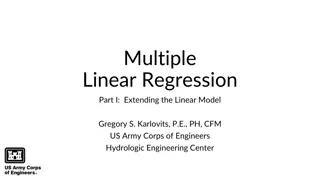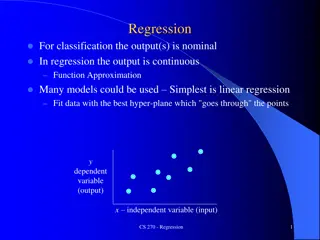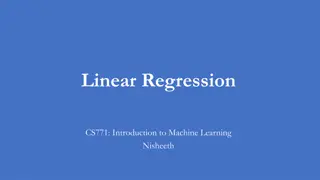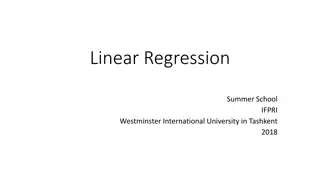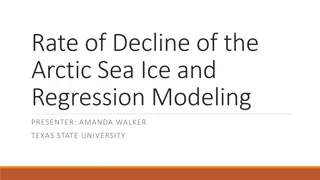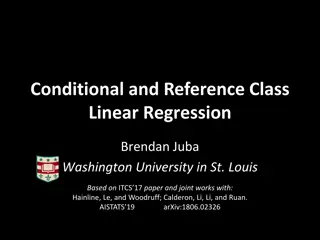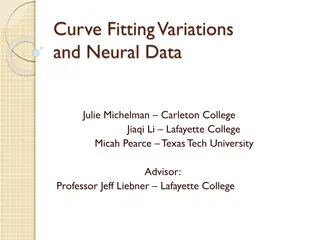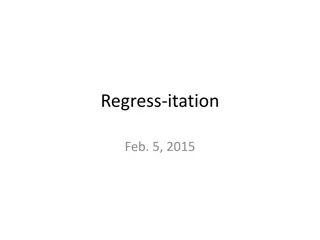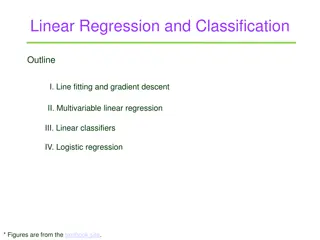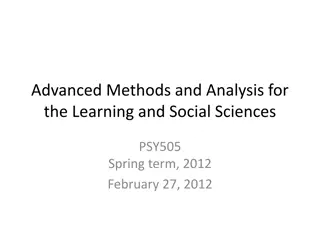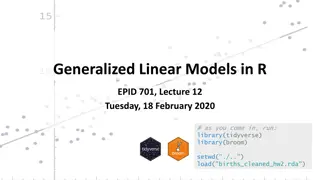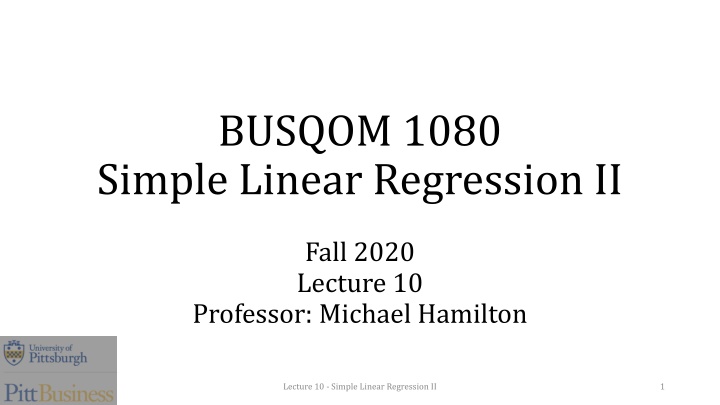
Linear Regression: Understanding Assumptions and Testing Methods
Learn about simple linear regression, ordinary least squares approach, confidence intervals, R-squared, and regression with multiple variables. Explore probabilistic linear models, assumptions, and ways to check them. Review how to test for independence in regression models.
Download Presentation

Please find below an Image/Link to download the presentation.
The content on the website is provided AS IS for your information and personal use only. It may not be sold, licensed, or shared on other websites without obtaining consent from the author. If you encounter any issues during the download, it is possible that the publisher has removed the file from their server.
You are allowed to download the files provided on this website for personal or commercial use, subject to the condition that they are used lawfully. All files are the property of their respective owners.
The content on the website is provided AS IS for your information and personal use only. It may not be sold, licensed, or shared on other websites without obtaining consent from the author.
E N D
Presentation Transcript
BUSQOM 1080 Simple Linear Regression II Fall 2020 Lecture 10 Professor: Michael Hamilton Lecture 10 - Simple Linear Regression II 1
Lecture Summary 1. Review simple linear regression. [5 Mins] 2. Explain ordinary least squares approach to regression. [5-10 Mins] 3. Confidence intervals and prediction intervals. [5 Mins] 4. R2 [5 Mins] 5. Preview: regression with multiple independent variables. [5 Mins] Lecture 10 - Simple Linear Regression II 2
Data for lecture Save mlb.txt mlb.txt in your working directory mlb =read.table("mlb.txt", sep = "\t", header = T) 30 Teams Column Name Column Name Variable Definition Variable Definition Stats from 17 AvgRuns Runs Scored Per Game OBP On-Base Percentage SLG (Total Bases)/(At Bats) OPS One base plus slugging HR Homeruns Many others ~Baseball Stuff~ 3 Lecture 10 - Simple Linear Regression II
Review: Simple Linear Regression Assumed Probabilistic Linear Model: Assume a linear relationship between X & Y exists Error term is assumed to be Normal with mean 0 Observed Y values can be expressed as: + = y 0 The straight line (average) + x 1 Deviation from the line Use data to estimate that linear relationship with a straight line: + = y x 0 1 Lecture 10 - Simple Linear Regression II 4
Probabilistic Linear Model: Assumptions How to check if data plausibly comes from assumed linear model i.e. : ? = ?0+ ?1? + ? 1. Linear association between variables Linearity Examine Residuals vs. Fitted plot 2. Normality of the distribution of errors Normality Examine Normal Q-Q plot 3. Independence of X and ? Independence Use Durbin-Watson test 4. Constant variance Constant Variance Examine Residuals vs. Fitted plot Lecture 10 - Simple Linear Regression II 5
Regression Assumptions: Independence install.packages( lmtest ) Use dwtest(model) Testing if residuals from regression model are correlated: Large p-value Residuals not correlated (GOOD) Small p-value Correlated residuals (BAD) Lecture 10 - Simple Linear Regression II 6
Topic: Checking Assumptions using gvlma() install.packages( gvlma ) Data satisfies regression assumptions 7
Topic: How Linear Regression is Fit 1. 2. Data: (xi, yi) pairs Goal: Find a linear model (straight line) that best fits the data Equivalently: Find coefficients ?0, ?1 for linear model: Qu: How do we find this model (i.e line of best fit)? ? = ?0+ ?1? Qu y 60 40 20 0 x 0 20 40 60 8 Lecture 10 - Simple Linear Regression II
Topic: How Linear Regression is Fit 1. How would you draw a line through the points? 2. How do you determine which line is the best fit ? 3. If there were very many points, how could a computer find the line? y 60 40 20 0 x 0 20 40 60 9 Lecture 10 - Simple Linear Regression II
Topic: Ordinary Linear Squares (OLS) Idea Idea: OLS chooses the line that minimizes the errors, i.e. sum of squared residuals (squared distances from the observed y values and the line) = + + y y 1 2 x 2 0 2 ^ 4 ^ 2 ^ 1 3 ^ = + i y x 0 1 i x 10 Lecture 10 - Simple Linear Regression II
Topic: Ordinary Linear Squares (OLS) Mathematically find ?0, ?1 by solving: ??? ?0, ?1 ?(?? ?0 ?1 ??)2 = ??? ?0, ?1 ???2 = + + y y 1 2 x 2 0 2 ^ 4 ^ 2 ^ 1 3 ^ = + i y x 0 1 i x 11 Lecture 10 - Simple Linear Regression II
Topic: Ordinary Linear Squares (OLS) What makes OLS good? Why not minimize some other metric? These estimates are unbiased, i.e. E[ ?] = ? (expectation over data observed) These estimates have the minimum variance of all unbiased estimators Key point: The estimates from OLS for the coefficients are deterministic functions of the data points, thus the coefficients that are found are themselves random variables! Under the assumptions of the probabilistic linear model, we can derive confidence intervals around the parameters, and around predictions from the model. 12 Lecture 10 - Simple Linear Regression II
Review: Simple Linear Regression in R 1. 1. 2. Data Data: (xi, yi) pairs Use lm() to do OLS regression (note this is by default in R) Finds coefficients ?0, ?1 for linear model: 3. 3. Example Example: Explain AvgRuns by team OPS ? = ?0+ ?1? 13 Lecture 10 - Simple Linear Regression II
Confidence Interval for the Fitted Parameters Saved regression model Confidence Interval for Slope Interpretation : AvgRuns increase by 1.08 to 1.4 for a .1 increase in OPS Lecture 10 - Simple Linear Regression II 14
Topic: Prediction with Lin. Reg. The goal of regression is often prediction. If the assumptions of the model Assumed Probabilistic Linear Model hold, we can use that understanding of the data generating process to predict responses of new observations! Confidence interval Confidence interval for the mean response ( = E[y|x]) The interval of values for the mean among observations with a specific x value Typically a narrower interval; easy to predict the population mean Prediction interval Prediction interval for an individual new observation (just y) The interval of values for a specific observation with a specific x value A much wider interval; difficult to predict a new observation (more variability) Lecture 10 - Simple Linear Regression II 15
Topic: Prediction with Lin. Reg. in R For a given set of values x1, , x5 (say, 5 teams), the predict() function calculates: 5 Fitted values (plug each x into regression equation) 5 Confidence intervals for the average y for each x 5 Prediction intervals for a new observation for each x In R: 1. Create dataframe with values to be predicted from 2. predict(model, new data, interval = confidence , level = 0.95) 3. predict(model, new data, interval = prediction , level = 0.95) Lecture 10 - Simple Linear Regression II 16
Topic: Prediction with Lin. Reg. in R New data must be a data frame. Use the same column names as original dataset Same fitted values 95% confidence interval for AvgRuns when OPS is .739 95% prediction interval for AvgRuns when OPS is .739 Lecture 10 - Simple Linear Regression II 17
Topic: R2 for Linear Reg. R2 (R-Squared) is the proportion of variability in Y accounted for by the model (i.e. predictor variable(s)) (note: Sometimes called the Coefficient of Determination Formula: R2 = SS Regression/ SS Total For simple linear regression note R2 is equal to r2 (the correlation squared!) General formula compares the sum of squares due to the regression (model) with the total variability Example Example: Value of 0.50 indicates that, 50% of the overall variation in the outcome has been explained by the explanatory variable Reading R2: Values near 1 look imply a tight clustering of the data about some line, while smaller values correspond to scatterplots with more spread of the points around the best fit line. 0 means no linear relationship between X and Y 1 means all of the data falls on a perfect straight line Coefficient of Determination) Lecture 10 - Simple Linear Regression II 18
Preview: Beyond Simple Linear Regression Data Data: (yi, xi,1 , xi,2, ,xi,k) i.e. k (> 1!) pieces of numeric info per obs. Find coefficients of line : ? = ?0 + ?1?1, ,+ ??xk Least Squares Method ??? ?0, ?1, , ?? ?(?? ?0 ?1 ??,1 ?? ??,?)2 Testing the linear relationship between each predictor and the response Now, controlling for other variables Slightly changes interpretation Lecture 10 - Simple Linear Regression II 19


